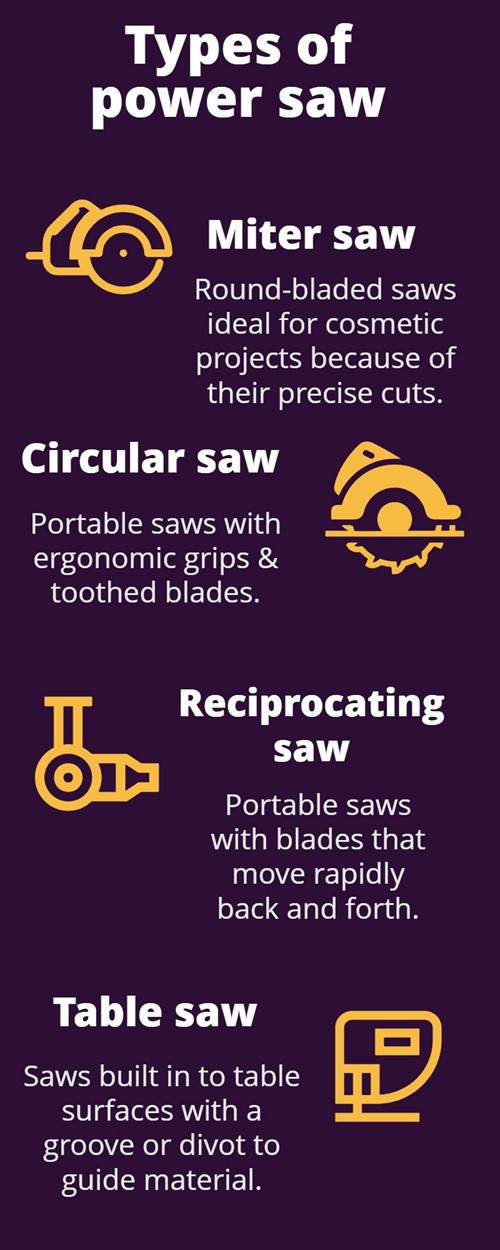
When it comes to cutting, saws are among the first tools many folks think of. Most think of a household hack saw or common rip-cut saw, both needing only a little elbow grease to cut through whatever medium you may be using. But what about power saws?
While hand saws are very common in the home, some power saws are equally common, though their primary use may be a little daunting at first.
Check out these four basic power saws and their primary function around the home:
Miter saws
Miter saws make home improvement projects, especially cosmetic ones, much easier thanks to the precision of their cuts. They're often characterized by having a circular blade attached to an arm that fits into the grooves outlined in the saw's base.
This allows homeowners and DIY enthusiasts more ease of use when creating miter joints, such as two pieces of crown molding cut to fit at a perfect 90-degree angle. Compound miter saws are also an excellent choice for individuals hoping to achieve perfect angled cuts, straight cuts and any combination of the two.
Circular saws
Circular saws tend to have a circular, toothed saw blade - often complete with saw guard - that are portable. These saws have grips in ergonomic and strategic places to ensure the user can safely cut through whatever surface they need to. However, because they are not stationary and don't have a base of their own, like miter saws, they often need a sawhorse or saw bench.
Reciprocating saws
Unlike circular saws, reciprocating saws are straight blades that move back and forth, much like a rip-cut saw. These saws are portable and have a plug-stable power supply or are battery operated. They're fully portable and are exceptional for cutting piping, small pieces of wood, drywall and other small or harder to reach items and areas.
Table saws
Unlike their counterparts, table saws are usually stationary. They often have a saw in the center of the table, with a divot that allows the saw to safely operate and slice through wood, soft metal, piping and other durable materials.
These vary in size and should be used in an area with plenty of room to avoid injury or inhalation of sawdust. They may also come in a variety of materials such as heft composite table surfaces, metal or other industrial materials.
These are just a few of the most dominant and common saws many homeowners and DIYers may find in their repertoire. If you're just starting out, these basics are excellent ways to determine which type of saws you may need for your projects, their defining characteristics and when you may use them.

If you're ever in doubt over how to use a certain type of saw or are simply uncomfortable using one, find a professional contractor to help out with any projects you may be engaging in. They'll have a wealth of knowledge and the expertise to help you successfully complete your home improvement goals.
About the Author

Debbie Caldwell
When you first meet Debbie Harris-Caldwell, you are immediately drawn to her charming Welsh accent and the twinkle in her eye. The well-traveled transplant from Wales is quick to set you at ease and time spent with her promises to be time well spent.
Debbie has been a real estate agent for 40 years and takes great pride in her customer service skills. "I make myself available to my customers when they need me, whether it's on a Sunday Evening or after their long day at work. I make my schedule fit theirs. I also keep my customers updated on everything happening with their listings or purchase, I am their conduit for information." She has built a business following her key principles of clear communication, attention to detail, client advocacy, and comprehensive knowledge of the area. Debbie comes to every new transaction with positive energy, determination, a strong understanding of the currents driving the market, and the expertise that comes from a lifetime of experience. She knows the importance of marketing and whether a home is for sale for $200,000 or for $2 million, she always has professional photography done and creates a listing presentation that best shows off her customer's home.